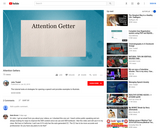
This video tutorial explains various strategies for how to start a speech and provides videos examples to illustrate.
- Subject:
- Business and Communication
- Communication
- Material Type:
- Diagram/Illustration
- Author:
- John Tindell
- Date Added:
- 02/06/2019

This video tutorial explains various strategies for how to start a speech and provides videos examples to illustrate.

The first two weeks of this course are an overview of performing improvisation with introductory and advanced exercises in the techniques of improvisation. The final four weeks focus on applying these concepts in business situations to practice and mastering these improvisation tools in leadership learning.
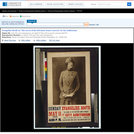
Poster features a photographic portrait of Evangeline Booth, standing, three-quarter length, in uniform and holding some papers. Copyright Ira L. Hill. Promotional goal: U.S. J7. F32. 1919. Exhibited: American Treasures of the Library of Congress.
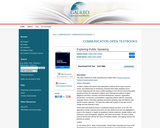
Instructors: The Third Edition includes a set of test banks which are not available to the public. For access to these resources, please contact Dr. Barbara Tucker at btucker@daltonstate.edu.
Exploring Public Speaking: The Free College Public Speaking Textbook began as the brainchild of Dr. Kris Barton, Chair of the Department of Communication at Dalton State College. It also was made possible through a generous Textbook Transformation Grant in 2015 from Affordable Learning Georgia, a highly successful program of the University System of Georgia. Dr. Barton asked me to help him author/compile the text.
The goal was to provide a high-quality, usable, accessible, and low-cost textbook for the hundreds of students who take COMM 1110 at Dalton State College every year. This course is required of all degree-seeking students. We have been able to save students hundreds of thousands of dollars already with this text. Unexpectedly and happily, the text has also been downloaded close to 14,000 times (as of August 2018) all over the world and has been adopted at many other institutions.
Dr. Barton and I worked on creating the textbook from July 2015 until May 2016, with the goal of going live with the text in Summer of 2016. Tragically Dr. Barton passed away in early May, a reality that still does not seem real. He has been greatly missed as a friend, colleague, father, scholar, teacher, and mentor.
The launch of the book proceeded; however, due to the loss of Dr. Barton, the ancillaries were not finished. In Summer 2017 I took on a significant revision and updating which I named the Second Edition. I included in that edition information on college student success in the appendices. In January 2018, a colleague, Matthew LeHew, and I won a grant from the University System to create the ancillaries and improve the format for more accessibility. I decided to remove the “Dalton State” from the title and most examples for wider appeal. An appendix on library research retains the information for specific use of Roberts Library on our campus.
Over 90% of the book is original with Dr. Barton, me, or other colleagues at Dalton State College. Some parts, specifically from Chapters 9, 10, and 15, are adapted from another open resource public speaking text whose author prefers not to be cited.
This Third Edition, along with including necessary updates and being formatted with different software, includes four more appendices: one on online speaking, one on APA, one on humor and storytelling in public speaking, and one on Dalton State’s Library. I have also tried to clarify concepts, to provide “case studies” to show the rhetorical process, and include more outlines and examples.
We think this book is especially useful in coverage of PowerPoint, audience responsiveness, ethics in public speaking, special occasion speeches, and structure of speeches. Three ancillaries are available: electronic “flash cards” for study, Powerpoints on the 15 main chapters, and test banks for the 15 main chapters.
Thank you for downloading Exploring Public Speaking, and the co-authors and I truly wish you happy teaching and learning with it. We welcome input. If you choose to use it, let us know at btucker@daltonstate.edu.

From Communication Apprehension to Relaxation and Emotion: How Including Indian Content in Speeches Facilitates Delivery
This OER will describe the journey of students taking the Public Speaking class at Aaniiih Nakoda College during the 2006-2014 period. In this OER, I share lesson plans as well as best practices learned, and how the inclusion of Indian content helped students to conquer their fear of public speaking and to share their sentiments about topics that mattered to them.

This textbook is a Fundamentals of Communication Textbook that includes intrapersonal communication, interpersonal communication, group communication, conflict management, and public speaking.
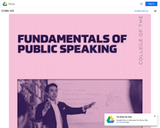
Examines the principles and practices of public speaking, communication theory, and techniques for public speaking. Includes speech organization, development, research, audience analysis, reasoning, and presentation skills for the development of informative and persuasive speeches.
Chapter 1: Introduction to Public Speaking
Chapter 2: Ethics
Chapter 3: Speaking With Confidence
Chapter 4: Listening Effectively
Chapter 5: Audience Analysis
Chapter 6: Organizing and Outlining
Chapter 7: Introductions and Conclusions
Chapter 8: Delivering Your Speech
Chapter 9: Visual Aids
Chapter 10: Supporting Your Ideas
Chapter 11: Using Language Well
Chapter 12: Informative Speaking
Chapter 13: Critical Thinking & Reasoning
Chapter 14: Persuasive Speaking
Occasion Speaking
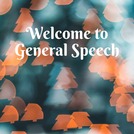
Modules that contain readings, videos, discussion questions, tests, quizzes, rubrics and more.

This video shows how to give a speaker time signals during an academic style speech (like those given in basic public speaking classes).Printable Time Cards ...

Are your students struggling to create visually-organized speech outlines? This GoogleDocs handout demonstrates Harvard outline formatting, the most common type of outlining used in public speaking. It explains and demonstrates formatting expectations for: speech sections, main points, transitions, sub-points. It also offers advice about: indentation and symbolization, the principle of division in outlining, how to adjust your numbering scheme in GoogleDocs and Microsoft Word, spacing. Finally, it offers two student outline examples for clarity.

This video covers some good practices to consider when putting together a home speech space to use in online public speaking and competitive forensics situations. Different instructors may have different ideas on how they want you to configure your space. Make sure you check with them before recording / giving your speech.

This module features a step-by-step process to create an informative speech. It provides concise instructions supported by topical learning resources (textbook chapters, short online articles, brief videos).

Students learn public speaking techniques with opportunities to learn The FFA Creed integrated throughout the curriculum. Students will be introduced to the techniques and continuously rehearse the techniques. By the end of the lesson, students can stand and deliver The FFA Creed to their class. This lesson plan is designed so that teachers may use it at the beginning or end of a class period and still cover other curriculum in the class.

In addition to original material this book is an adaptation of Introduction to Speech Communication authored by Sarah E. Hollingsworth, Kathryn Weinland, Sasha Hanrahan, and Mary Walker with a CC BY-NC-SA license. Introduction to Speech Communication includes original work as well as adapted and remixed material from Exploring Public Speaking: 4th Edition licensed CC BY-NC-SA, Stand Up, Speak Out licensed CC BY-NC-SA, and Fundamentals of Public Speaking licensed CC BY.
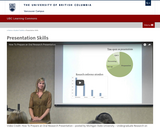
One of a set of toolkits to support student development and personal reflection. Produced by students for students.

Overview: Presented in five consecutive standard-period classes, students will think critically about an experience in their lives that have made a lasting, positive impact for which they are grateful. Students will write and hone rough drafts, give and solicit peer review and teacher critique, and develop a three-minute oral presentation of the final draft to their class. Lesson by Jarvis L. Reed.
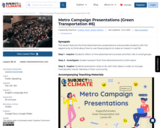
SYNOPSIS: This lesson features the final advertisement presentations and provides students with the opportunity to think about how to use these projects to make an impact in real life.
SCIENTIST NOTES: The lesson gives students a chance to reflect on the power of advertisement and ways to engage the public to use the metro as a sustainable green transportation model. The materials used in the lesson have been verified and are accurate. Hence, this lesson is recommended for classroom use.
POSITIVES:
-Students explore real-world problems through project-based learning.
-Students practice oral presentation skills.
-Students practice giving constructive feedback to their peers.
-This lesson empowers students to continue their projects after the allotted class time has ended.
ADDITIONAL PREREQUISITES:
-This is lesson 6 of 6 in our 3rd-5th grade Green Transportation unit.
-You can review a code of conduct or guidelines for oral presentations prior to this lesson. This can include an introduction for how to be a prepared speaker and active listener.
DIFFERENTIATION:
-You may scaffold reflection questions with sentence frames.
-You can decide on alternative ways to conduct student presentations based on students' needs.
-Potential action projects for students are listed on slide 14 of the teacher slideshow.

The ND Academy website (https://NDAcademy.FoxPing.com/) provides links to: 1) Electronics Is Easy? (electronic engineering), 2) Khan Academy (math, science, history, etc.), 3) Boseman Science (chemistry, physics, etc.). 4) Robert's Rules of Order in a Nutshell (efficient, professional meetings), 5) Cochlear Implants (deafness is a more severe handicap than blindness).

Learns tips for oral communication!
Stock footage: Pexels.com

This three-week module, centered on a focal case, represents the second part of the Department’s introduction to the challenges of reflection and action in professional planning practice. As such, it builds on the concepts and tools in 11.201 and 11.202 in the fall semester. Working in teams, students will deliver a 20-minute oral briefing, with an additional 10 minutes for questions and comments, in the last week of the class (as detailed on the assignment and posted course schedule). The teams will brief invited guests (“briefees”) taking the roles of decision makers. DUSP faculty and fellow students may also be in attendance.